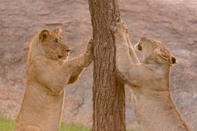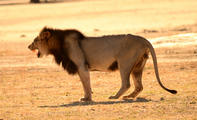Lion Territory
Its commonly thought that a pride of lion comprises a single dominant male and his females, this is not the case. A territory is held by several males in partnership known as a coalition.

There can be between two and five males in a coalition and their territory overlaps with a number of different mutually exclusive female territories. Working as a team, it is easier to dispossess older lions of their domain and keep hyenas at bay, lions’ chief competition.
Collectively the males are a stronger force, can defend a larger territory and protect more females. They will split up to do patrols but rejoin as necessity requires. The coalition may be, but not always, made up of brothers. In this instance, the cooperative effort serves the perpetuity of the family genes.
Females do most of the hunting although males do assist with larger kills like giraffe and buffalo. Males are adept hunters when they are on their own. Males will be the first to eat sometimes take over the entire carcass to the exclusion of the females that killed it or even their own cubs.
The females tolerate this behaviour both because the males are larger and stronger than them and because the males afford the females protection by defending the territory against hyenas and other male lions. Foreign males that move into the territory will kill all the cubs in a pride under one-year-old.
This infanticide is executed to bring females into heat quickly so that they might mate with the pride females and then spend their tenure as the territorial coalition defending their own offspring. Interestingly, the females don’t conceive immediately and the males need to establish themselves before they will.
This mechanism is to prevent wasted reproductive energy as should the new males be displaced soon after take over, a similar process will occur and the females will again lose their cubs.
A Lions Roar

Lions roar to advertise their territory or to locate other members of the pride. They do this at night predominantly as this is when they are most active but also because the air is stiller and sound carries further.
It is estimated that the roar of a lion carries over seven kilometres in distance depending on the time of year and weather. Lions recognize individual roars and will respond to one another if it is relevant to do so.
By Megan Emmett